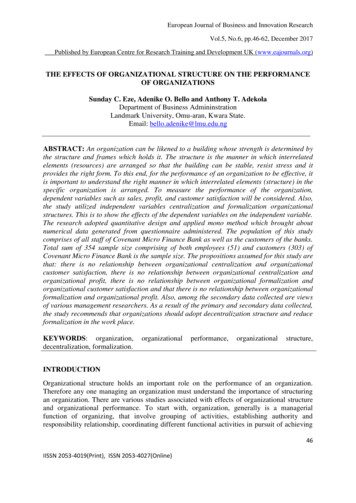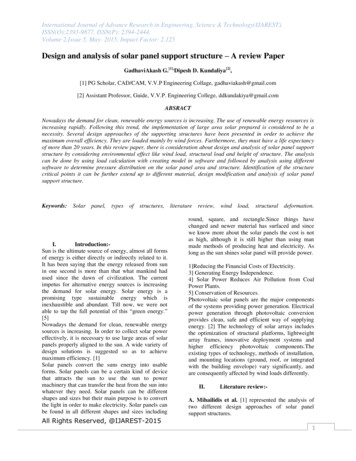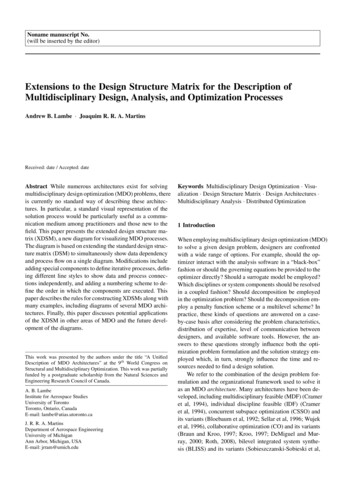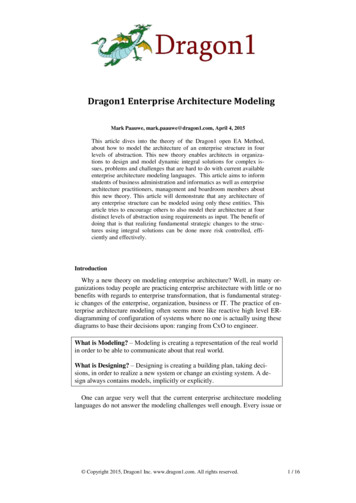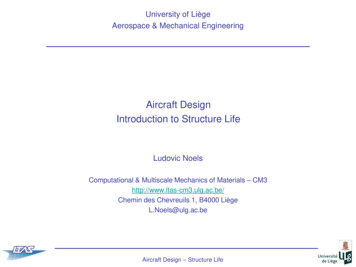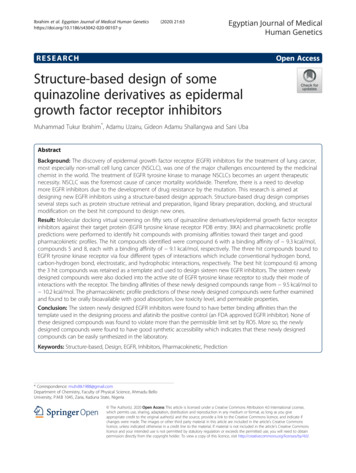
Transcription
Ibrahim et al. Egyptian Journal of Medical Human (2020) 21:63Egyptian Journal of MedicalHuman GeneticsRESEARCHOpen AccessStructure-based design of somequinazoline derivatives as epidermalgrowth factor receptor inhibitorsMuhammad Tukur Ibrahim*, Adamu Uzairu, Gideon Adamu Shallangwa and Sani UbaAbstractBackground: The discovery of epidermal growth factor receptor (EGFR) inhibitors for the treatment of lung cancer,most especially non-small cell lung cancer (NSCLC), was one of the major challenges encountered by the medicinalchemist in the world. The treatment of EGFR tyrosine kinase to manage NSCLCs becomes an urgent therapeuticnecessity. NSCLC was the foremost cause of cancer mortality worldwide. Therefore, there is a need to developmore EGFR inhibitors due to the development of drug resistance by the mutation. This research is aimed atdesigning new EGFR inhibitors using a structure-based design approach. Structure-based drug design comprisesseveral steps such as protein structure retrieval and preparation, ligand library preparation, docking, and structuralmodification on the best hit compound to design new ones.Result: Molecular docking virtual screening on fifty sets of quinazoline derivatives/epidermal growth factor receptorinhibitors against their target protein (EGFR tyrosine kinase receptor PDB entry: 3IKA) and pharmacokinetic profilepredictions were performed to identify hit compounds with promising affinities toward their target and goodpharmacokinetic profiles. The hit compounds identified were compound 6 with a binding affinity of 9.3 kcal/mol,compounds 5 and 8, each with a binding affinity of 9.1 kcal/mol, respectively. The three hit compounds bound toEGFR tyrosine kinase receptor via four different types of interactions which include conventional hydrogen bond,carbon-hydrogen bond, electrostatic, and hydrophobic interactions, respectively. The best hit (compound 6) amongthe 3 hit compounds was retained as a template and used to design sixteen new EGFR inhibitors. The sixteen newlydesigned compounds were also docked into the active site of EGFR tyrosine kinase receptor to study their mode ofinteractions with the receptor. The binding affinities of these newly designed compounds range from 9.5 kcal/mol to 10.2 kcal/mol. The pharmacokinetic profile predictions of these newly designed compounds were further examinedand found to be orally bioavailable with good absorption, low toxicity level, and permeable properties.Conclusion: The sixteen newly designed EGFR inhibitors were found to have better binding affinities than thetemplate used in the designing process and afatinib the positive control (an FDA approved EGFR inhibitor). None ofthese designed compounds was found to violate more than the permissible limit set by RO5. More so, the newlydesigned compounds were found to have good synthetic accessibility which indicates that these newly designedcompounds can be easily synthesized in the laboratory.Keywords: Structure-based, Design, EGFR, Inhibitors, Pharmacokinetic, Prediction* Correspondence: muhdtk1988@gmail.comDepartment of Chemistry, Faculty of Physical Science, Ahmadu BelloUniversity, P.M.B 1045, Zaria, Kaduna State, Nigeria The Author(s). 2020 Open Access This article is licensed under a Creative Commons Attribution 4.0 International License,which permits use, sharing, adaptation, distribution and reproduction in any medium or format, as long as you giveappropriate credit to the original author(s) and the source, provide a link to the Creative Commons licence, and indicate ifchanges were made. The images or other third party material in this article are included in the article's Creative Commonslicence, unless indicated otherwise in a credit line to the material. If material is not included in the article's Creative Commonslicence and your intended use is not permitted by statutory regulation or exceeds the permitted use, you will need to obtainpermission directly from the copyright holder. To view a copy of this licence, visit http://creativecommons.org/licenses/by/4.0/.
Ibrahim et al. Egyptian Journal of Medical Human Genetics(2020) 21:63BackgroundOne of the major challenges faced by the medicinalchemist was discovering epidermal growth factor (EGFR)receptor inhibitors for treating lung cancer, especially,non-small cell lung cancer ( NSCLC) or EGFR tyrosinekinase mutations [1]. Treatment of EGFR tyrosine kinaseto control NSCLCs has become an urgent therapeuticrequirement due to the development of drug resistanceby the mutation [2].Lung cancer was one of the world’s leading cancerproblems. A lot of deaths are recorded every year, estimated to be around one third of all cancer deaths. Nonsmall cell lung cancer (NSCLC) was the main subset oflung cancers that accounted for about 85% of cancerrelated problems [3]. Overexpression of epidermal growthfactor receptor kinase was identified to be the commoncause of NSCLCs. Based on the report on the populationof patients with NSCLCs in Caucasia, the figure is approximately 10–15% and in Asia is approximately 30–40%, respectively [3].NSCLC therapeutic agents showed a high responserate in patients with increase modifications of EGFR.NSCLC therapeutic agents or EGFR inhibitors were classified into reversible EGFR inhibitors (first-generationEGFR inhibitors) and irreversible EGFR inhibitors (second- and third-generation EGFR inhibitors). Unfortunately, the potency period of these first-generationEGFR inhibitors (Gefitinib and Erlotinib) is shorteneddue to the development of drug resistance by the secondary mutation T790M [4]. The second-generation irreversible EGFR inhibitors, such as afatinib andcanertinib, were subsequently developed for the treatment of the NSCLC EGFRT790M mutations [5]. However,due to severe side effects, such as skin rashes and diarrhea, the second-generation EGFR inhibitors could notshow any significant advantage over the first-generationreversible EGFR inhibitors. It is believed that the activities upon wild-type EGFR will narrow the possible activities on the patients with the T790M mutation [1, 6–8].To address the unmet clinical demands, many thirdgeneration irreversible EGFR inhibitors such as WZ4002,Rociletinib, Olmutinib, and Osimertinib were designed toinhibit the T790M resistance mutation while being moreselective for wild type EGFR [1, 9–12].In structure-based design, molecular docking is usedto screen a library of compounds to identify compoundswith higher affinities toward their target protein [13].ADME and drug-likeness properties prediction played avital role in structure-based design in the determinationof the pharmacokinetic profiles of drug-like compoundsin the early stage of drug development [14].The purpose of this work is to apply the concept ofstructure-based design on fifty sets of quinazoline derivatives (EGFR inhibitors) previously reported in literaturePage 2 of 12and design new quinazoline derivatives (new EGFR inhibitors) that may have better binding affinities than theprevious quinazoline derivatives and further evaluatetheir pharmacokinetic properties.MethodComputational environment and toolsThis computational work was carried out on a Dell personal computer laptop, with the following specifications:Intel Core i7 Dual CPU, M330 @2.75 GHz 2.75GHz,and 8GB of RAM. The following software was utilized toachieve the success of this research: Pyrex virtual screening software, UCSF Chimera, Discovery studio, andSWISSADME an online web tool.Compounds under investigationFifty sets of quinazoline derivatives as EGFR inhibitorspreviously reported by Zhang et al. were collected andused in this research work [15]. The compounds underinvestigation were synthesized under the same condition.After the retrieval of the compounds under investigation,the 2D structures of all the compounds were drawn withthe help of Chemdraw software and presented in theSupplementary Table 1 [16, 17].Ligand data preparationLigand preparation is very vital and also an importantstep in molecular docking study. As such, the preparation of the ligands in this work was done by finding themost optimum geometries of all the compounds underinvestigation, at B3LYP/6-311G* level of theory, withdensity functional theory (DFT) method using Spartan14 wave software [18]. The optimum conformations ofall the compounds under investigation were then savedin protein data bank file format for the next step. A prepared 3D conformation of one of the compounds underinvestigation/ EGFR inhibitor is shown in Fig. 1.EGFR enzyme preparationThe crystal structure of the epidermal growth factor receptor tyrosine kinase enzyme covalently binding toWZ4002 with protein data bank entry: 3IKA was retrieved from the RCSB protein data bank database. Aftersuccessful retrieval of the enzyme, the preparation of theenzyme for the molecular docking simulation was doneusing a discovery studio visualizer. In the process of itspreparation, the co-crystallized ligand (WZ4002) andmolecule of water present on the structure were deleted.Before that, polar hydrogen was added to the crystalstructure. The 3D structure of the prepared EGFR tyrosine kinase enzyme is shown in Fig. 2.
Ibrahim et al. Egyptian Journal of Medical Human Genetics(2020) 21:63Page 3 of 12Fig. 1 A 3D conformation of a prepared EGFR inhibitorMolecular docking executionThe docking of the compounds/EGFR inhibitors/ligandsunder investigation in the active site of the EGFR tyrosine kinase enzyme was achieved with the help of Autodock vina of Pyrex virtual screening software [19]. UCSFChimera software was used for the re-coupling of thedocked ligand with the receptor. The discovery studiovisualizer was used to visualize the re-coupled complexes so as to view the nature of interactions betweenthe ligands and the enzyme.the information regarding the three-dimensional structureof the molecular target (protein) through methods such asX-ray crystallography, NMR spectroscopy, or homologymodeling, followed by the design of suitable drug candidates based on the binding affinities and selectivity fortheir target molecules. Structure-based drug design comprises several steps such as protein structure retrieval andpreparation, ligand library preparation, docking, and manual design of new compounds [23].ResultsPharmacokinetic profile predictionMolecular docking simulationThe drug-likeness evaluation and ADMET screeningwere further performed using the SwissADME free webtool, developed by the Swiss Institute of bioinformatics,and freely available at http://www.swissadme.ch [20]. Allthe compounds under investigation were subjected tothis part of in silico screening as filtering criteria in compliance with Lipinski’s rule of five (RO5) [21, 22].The results of the molecular docking simulation of thebest top ten compounds are presented in Table 1 andFig. 3a, b, respectively.Drug-likeness and ADME property predictionThe results of the drug-likeness and ADME propertiesprediction for the best top ten compounds are presentedin Tables 2 and 3, respectively.Structure-based designStructure-based drug design is a very important, robust,and useful technique in the drug discovery arena. It is alsocalled direct drug design which involves the acquisition ofFig. 2 3D structure of the prepared EGFR tyrosine kinase enzymeDesignThe structures and binding affinities of the template andthe newly designed compounds are given in Table 4.
GLN791, PRO794, & GLY796GLN791, ASP855, CYS797, ASN842, PRO794,& GLY796GLN791, ASP855 PRO794, & GLY796UNK1GLN791, PRO794, & GLY796GLN791, GLN791, ARG841, PRO794, & GLY796 3.04006, 3.10979, 3.52195, 3.44184, & 3.31464GLN791, PRO794, & GLY796GLN791, PRO794, GLY796, & ARG841 9.3 9 9.1 8.3 8.5 8.8 8.7 8.6678912222934LYS745, ASP855, PHE723, LEU718, & VAL726ASP855 (2), LEU718, VAL726 (2), & PHE723UNK1, LYS745, VAL726 (2), LYS745, & PHE723Hydrophobic and electrostatic interactions2.89571, 3.36852, 3.34267, & 3.444262.93488, 3.37212, & 3.300432.91912, 3.33444, & 3.324383.487212.92147, 2.69743, 3.3526, & 3.30683ASP855, LYS745 (2), LEU718, VAL726 (2), & PHE723ASP855, LYS745 (2), LEU718, ARG841, VAL726 (2), & PHE723LYS745, ASP855, PHE723, LEU718, VAL726, & LYS745ASP855, LYS745 (2), VAL726 (2), LEU718, & PHE723LEU718 (2), LYS728, LEU792, VAL726, LEU844, & PHE723LYS745, LEU718, & VAL7262.98981, 2.09941, 2.78308, 3.61807, 3.31544, & 3.23449 ASP855, VAL726 (2), LEU718, & PHE7232.87813, 3.44185, & 3.373992.8768, 2.83195, 2.80635, 3.65564, 3.22827, & 3.2556GLN791, LYS745, CYS797, ASN842, PRO794,& GLY796 9.152.76935, 2.67256, 2.19566, 2.86768, & 3.27741GLN791, UNK1, LYS745, CYS797, & GLY796 8.4Bond distance (Å)3Ligand-receptor Binding affinity Hydrogen bond(3IKA)(kcal/mol)Table 1 The binding affinities and different interactions of the top ten compounds and EGFR receptorIbrahim et al. Egyptian Journal of Medical Human Genetics(2020) 21:63Page 4 of 12
Ibrahim et al. Egyptian Journal of Medical Human Genetics(2020) 21:63Page 5 of 12Fig. 3 The 2D structure of a Complex 6 and b Complex 8 using discovery studioMolecular docking investigation of the newly designedcompoundsDrug-likeness and ADME property prediction of the newlydesigned compoundsThe results of the molecular docking of the newly designed compounds are presented in Table 5 and Fig. 4a,b, respectively.The results of the drug-likeness and ADME propertiesprediction for the designed compounds are presented inTables 6 and 7, respectively.
Ibrahim et al. Egyptian Journal of Medical Human Genetics(2020) 21:63Page 6 of 12Table 2 Drug-likeness properties of ten top compoundsMoleculeMWTPSAWLOGPNo. of H-bond donorsNo of H-bond acceptorsRO5 violationsMolecule 3501.46114.474.44391Molecule 5534.9794.64.11271Molecule 6500.5294.64.46271Molecule 7517.96107.494.95271Molecule 9400.4385.373.54250Molecule 12428.8485.374.69260Molecule 22557.6297.844.39281Molecule 2952688.614.16271Molecule 34560.04124.894.61281Molecule 43441.5279.383.85250DiscussionMolecular dockingMolecular docking virtual screening, one of the methodsapplied in structure-based drug design, was used toscreen fifty sets of EGFR inhibitors in order to identifyhit compound that could be used to design new EGFRinhibitors by investigating their binding interactions inthe active site of EGFR tyrosine kinase enzyme (3IKA)(Supplementary Table 2). The binding affinities of thisdocking study presented in Supplementary Table 2 in kcal/mol range from 7.1 kcal/mol to 9.3 kcal/mol. Also, allpossible interactions (hydrogen bond, hydrophobic, andelectrostatic interactions) between the ligands and the target protein were shown in the same table. The results ofthe best top 10 compounds under investigation with higherbinding affinities/lower docking scores is presented in Table1 out of which the best three are discussed.The best three hit compounds identified were compound 6 with the highest binding affinity of 9.3 kcal/mol, followed by compounds 5 and 8, each with thebinding affinity of 9.1 kcal/mol, respectively. The besthit compound 6 bound to EGFR tyrosine kinase receptorvia four different types of interactions includingconventional hydrogen, carbon-hydrogen, electrostatic,and hydrophobic bond interactions, respectively. Nitrogen one (N1) of the quinazoline ring of compound 6binds to EGFR tyrosine kinase receptor via conventionalhydrogen bond interaction with GLN791 amino acidresidue with a bond distance of 2.87813 Å. PRO794 andGLY796 amino acid residues formed carbon-hydrogenbonds with the active site of the receptor each with abond distance of 3.44185 Å and 3.37399 Å, respectively.EGFR tyrosine kinase receptor interacted also via threehydrophobic interactions with PHE723, LEU718, andVAL726 amino acid residues with different parts of thecompound, respectively. Furthermore, electrostatic interaction was observed between compound 6 and the activesite of the receptor with LYS745 and ASP855 amino acidresidues, respectively.Compound 5 was found to bind with the active site ofEGFR tyrosine kinase receptor via two hydrogen bonds(conventional and carbon-hydrogen), four hydrophobic,and two electrostatic interactions. The conventionalhydrogen bonds were between the hydrogen attached toone of the nitrogen of the quinazoline ring, oxygen ofthe acrylamide moiety, and fluorine on the benzyl ringTable 3 ADME properties of ten top compoundsMoleculeGI absorptionBBB permeantPgp substrateBioavailability scoreSynthetic accessibilityMolecule 3LowNoNo0.553.54Molecule 5LowNoYes0.554.18Molecule 6HighNoYes0.554.11Molecule 7HighNoYes0.554.16Molecule 9HighNoNo0.553.67Molecule 12HighNoNo0.553.58Molecule 22HighNoYes0.554.63Molecule 29HighNoYes0.554.32Molecule 34LowNoYes0.554.67Molecule 43HighNoYes0.553.48
Ibrahim et al. Egyptian Journal of Medical Human Genetics(2020) 21:63Table 4 The structure and binding affinities of newly designedcompounds and the templatePage 7 of 12of compound 5 with ASP855 (2.8768 Å), LYS745(2.83195 Å), and CYS797 (2.80635 Å) amino acid residueof the receptor, respectively. The carbon-hydrogen bondwas between the carbon and oxygen attached to thetetrahydrofuran-3-yl moiety and also carbon of theflourobenzyl ring with ASN842, PRO794, and GLY796amino acid residues of the receptor each with a bonddistance of 3.65564 Å, 3.22827 Å, and 3.2556 Å, respectively. A different part of the ligand was also observed tobind with the binding pocket of the receptor via twoelectrostatic and four hydrophobic bonds with ASP855(2), LEU718, VAL726 (2), and PHE723 amino acids.Compound 8 among the hit compounds formed twoconventional hydrogen bonds with GLN791 and ASP855amino acid residues, with a bond distance of 2.92147 Åand 2.69743 Å, respectively. Carbon-hydrogen bondswere also observed between the compound and the active site of the receptor with PRO794 (3.3526 Å) andGLY796 (3.30683 Å) residues, respectively. The compound was further observed to bind with the active siteof the receptor protein via hydrophobic and electrostaticinteractions with LYS745, LEU718, and VAL726 aminoacid residues, respectively.The common amino acid residues to these hit compounds were GLN791, LYS745, PRO794, GLY796,LEU718, and VAL726, respectively. These amino acidresidues might be responsible for their higher bindingaffinities. Furthermore, Fig. 3a, b shows the 2D structures of compounds 6 and 8 using discovery studiovisualizer.Drug-likeness and ADME property prediction of thestudied compoundsThe drug-likeness and ADME properties of all the compounds under investigation were predicted using SWISSADME online web tool. The drug-likeness and ADME properties of all the compounds are presented in SupplementaryTables 3 and 4 following the notable Lipinski’s rule of five. Itstates that the permeation of an orally administered compound is more likely to be better if the molecule satisfies thefollowing conditions: (i) hydrogen bond donors 5 (OHand NH groups), (ii) hydrogen bond acceptors 10 (N andO atoms), (iii) molecular weight 500, (iv) calculated WlogP 5 (v), and TPSA 140, respectively. Any compound thatviolates more than two of these conditions may havebioavailability-related problems. The results of the best top10 compounds are presented in Tables 2 and 3.All the compounds satisfied the Lipinski’s rule of fivewithout violating more than one of the conditions statedexcept compound 16 which has two violations. Thus, predicting their good permeability properties, easy transportation, absorption, and diffusion. The number of hydrogenbond acceptors and donors for all the compounds underinvestigation was less than 5 and 10, respectively, per the
GLN791 & GLY796GLN791 & GLY796LYS875, GLN791, PRO794, & GLY796ASP855, GLN791 &GLY796ASP855, GLN791, & GLY796ASP855 & MET793ASN842, ASP837, MET793, ARG841, THR854,& PHE723ASP855, ARG841, LYS875, GLN791, & GLY796 2.25702, 2.53282, 2.46915, 3.18433,& 3.47632ASP855, GLN791, PRO794, & GLY796ARG841, GLN791, PRO794, & GLY796MET793, MET793, & LEU718GLN791, GLY796, & PRO877GLN791 & GLY796ARG841, ARG841, GLN791, & GLY796GLN791, LEU718, ASP800, LEU718, MET793,& GLY796 9.7 9.5 9.8 10 10 9.6 9.7 10.2 10 9.5 9.5 10.1 9.6 10.1 7.9345678910111213141516AfatinibHydrophobic and other interactionsLYS745 (2), ASP855, PHE723, LEU718 (2), LYS875, ALA743,LEU844, VAL726, & LEU858LYS745 (2), ASP855, LEU844, PHE723, LEU718 (2), ALA743,VAL726, & LEU858LYS745, ASP855, LEU844, PHE723, LEU718 (2), LEU747,ALA755, VAL726, & ALA743LYS745 (3), ASP855, LEU718 (2), ALA743, LEU844, VAL726,& LEU858LYS745 (2), ASP85, LEU844, PHE723, LEU718 (2), VAL726,ALA743, & LEU747ASP837 (2), LYS745 (3), ASP855, LEU844, PHE723, PRO877,LEU718 (2), ALA743, VAL726, & LEU858LYS745, ASP855, LEU718 (3), CYS797 (2), ARG841, ALA743,LEU844, VAL726, & ARG841LYS745, ASP855, PHE723, LEU718 (2), ALA743, LEU844,VAL726, & LYS745LYS745 (3), ASP837, ASP855, LEU718 (2), ALA743, LEU844,VAL726, & LEU858LYS745 (2), ASP855, LEU844, LEU718 (2), PRO877 (2), LYS875,VAL726, ALA743, & LEU858ASP855, LEU718, GLY796, LEU844 (2), VAL726, LYS745,MET790 (2), LYS875, CYS797, & ALA743ASP855, LEU718, LEU844, MET790, PHE723, VAL726, CYS797,& ALA743LYS745 (3), ASP855, LEU718 (2), ALA743, LEU844, VAL726,& LEU858LYS745 (3), ASP855, LEU844, LYS875, LEU718 (2), PRO877,LEU858 (2), ALA743, & VAL7263.01018, 3.78965, 3.63169, 3.54526,3.11324, & 3.34059ASP855, LYS745, LEU718 (2), VAL726 (2), ALA743, LEU844,& PHE7232.90956, 2.69717, 3.21588, & 3.44122 LYS745 (3), ASP837, ASP855, LEU718 (2), LYS875, PRO877,VAL726, ALA743, LEU844, & LEU8583.07325 & 3.698253.09152, 3.40727, & 3.296492.7385, 2.00214, & 3.736572.67415, 3.15579, 3.7195, & 3.317562.74058, 3.225, 3.72385, & 3.344752.30969, 2.79936, 2.57049, 3.06555,2.9311, & 2.868452.50235 & 2.327162.67073, 3.26813, &3.455762.65139, 3.25938, & 3.495792.42771, 3.15611, 3.72875, & 3.37413 LYS745 (2), ASP855, PHE723, LEU718 (2), ALA743, LEU844,VAL726, & LYS8753.18431 & 3.362473.09658 & 3.396293.11371 & 3.36776GLN791 & GLY796 9.92Bond distance (Å)2.79452, 3.28946, & 3.4809ASP855, GLN791, & GLY796 101Ligand receptor (3IKA) Binding energy (kcal/mol) Hydrogen bondTable 5 The interactions of the designed compounds in the active site of the EGFR receptorIbrahim et al. Egyptian Journal of Medical Human Genetics(2020) 21:63Page 8 of 12
Ibrahim et al. Egyptian Journal of Medical Human Genetics(2020) 21:63Page 9 of 12Fig. 4 2D structures of the designed compound a SED 10 and b SED 14 in complex with EGFR enzyme using discovery studionotable RO5. From all these predicted parameters, it canbe predicted that all the compounds under investigationincluding the three hit compounds can be orally bioavailable and also orally active as they obeyed the notable RO5.For a drug to be orally active, it is expected to havehigh gastrointestinal absorption and all the compoundsunder investigation including the three hit compoundsexhibited high gastrointestinal absorption exceptcompounds 2, 16, 21, 34, and 39 with low gastrointestinal absorption. None of them was seen to permeantthrough the blood-brain barrier indicating lower toxicity.The most vital factor indicating good absorption was recognized to be the bioavailability score (which give theamount of drug present in the plasma). All the compounds under investigation including the three hit compounds were found to have high bioavailability scores of
Ibrahim et al. Egyptian Journal of Medical Human Genetics(2020) 21:63Page 10 of 12Table 6 Drug-likeness properties of the newly designed compoundsMoleculeMWTPSAWLOGPNo. of H-bond donorsNo of H-bond acceptorsRO5 violationsMolecule 1591.63106.637.2372Molecule 2674.55106.638.36372Molecule 3591.63106.637.2372Molecule 4626.08106.637.86372Molecule 5609.62106.637.76382Molecule 6626.08106.637.86372Molecule 7609.62106.637.76382Molecule 8674.55106.638.36372Molecule 9658.09106.638.51382Molecule 10641.64106.638.66392Molecule 11621.66115.867.21382Molecule 12621.66115.867.21382Molecule 13644.07106.638.42382Molecule 14644.07106.638.42382Molecule 15639.65115.867.77392Molecule 16656.1115.867.873820.55 except compound 16 which has a lower bioavailability score of 0.17. P-gp substrate served as a defender tothe central nervous system (CNS) from xenobiotics. Also,the P-gp substrate of all the compounds under investigation including the 3 hit compounds was predicted. Somewere found to be a substrate to P-gp while some were not.Moreover, synthetic accessibility scores refer to how easya compound can be synthesized in a laboratory and scalesof easy to hard range between 0 and 10. Synthetic accessibility score of all the compounds under investigation including the three (3) hit compounds was less than 5showing that they can be easily synthesized in the laboratory. The compounds under investigation including thethree hit compounds were predicted to have good pharmacokinetic profile and drug-likeness except compound16 [24, 25].Table 7 ADME properties of the newly designed compoundsMoleculeGI absorptionBBB permeantPgp substrateBioavailability scoreSynthetic accessibilityMolecule 1LowNoNo0.554.67Molecule 2LowNoNo0.554.88Molecule 3LowNoNo0.554.67Molecule 4LowNoNo0.554.66Molecule 5LowNoNo0.554.67Molecule 6LowNoNo0.554.67Molecule 7LowNoNo0.554.67Molecule 8LowNoNo0.554.87Molecule 9LowNoNo0.175.16Molecule 10LowNoNo0.554.84Molecule 11LowNoNo0.554.86Molecule 12LowNoNo0.554.83Molecule 13LowNoNo0.174.68Molecule 14LowNoNo0.174.69Molecule 15LowNoNo0.554.87Molecule 16LowNoNo0.554.87
Ibrahim et al. Egyptian Journal of Medical Human Genetics(2020) 21:63Designed compoundsBased on the virtual screening carried out using moleculardocking and pharmacokinetic studies on quinazoline derivatives, compound 6 with the highest binding affinity of 9.3 kcal/mol, good pharmacokinetic profile, and druglikeness property was identified as the best hit compoundin the analogs. Compound 6 being the best hit was usedas the template for designing new compounds. Sixteennew compounds (Table 4) were designed by carrying outstructural modification on the meta position of the flourobenzyl ring of compound 6 (the template). Studying thedesigned compounds, the addition of phenyl-amino ringsand halo substituted phenyl-amino rings on the meta position of the flourobenzyl ring attached to “oxy-phenylamino ring” moiety of the template significantly increasethe binding affinities of the designed compounds.Molecular docking investigation of the newly designedcompoundsThe newly developed compounds were also docked atthe active site of EGFR tyrosine kinase receptor (PDBcode: 3IKA). Table 5 shows the docking results of allthe newly designed compounds in the active site of thetarget protein (EGFR tyrosine kinase receptor). Thebinding affinities of these newly designed compoundsrange from 9.5 kcal/mol to 10.2 kcal/mol. Whencompared with the template and the control afatinib, thedocked-designed compounds were seen to have betterbinding affinities than the template (f 9.3 kcal/mol)and the control ( 7.9 kcal/mol).Designed compound SED10 was found to be the bestamong all designed compounds with a binding affinity of 10.2 kcal/mol. It interacted with the binding pocket ofEGFR tyrosine kinase receptor via three conventionalhydrogen bonds, two carbon-hydrogen bonds, four halogen bonds, three electrostatic bonds, and nine hydrophobic bonds with the following amino acid residues:ARG841, GLN791, GLY796, LYS745 (2), ASP855,LEU844, LEU718 (2), PRO877 (2), LYS875, VAL726,ALA743, and LEU858, respectively (Table 5).The second-best among the designed compounds wasSAD14. It bounded to the binding pocket of its target viathree carbon-hydrogen bonds, four halogen bonds, threeelectrostatic bonds, and nine hydrophobic bonds with thefollowing amino acids GLN791, GLY796, ASP837 (2),LYS745 (3), ASP855, LEU844, PHE723, PRO877, LEU718(2), ALA743, VAL726, and LEU858, respectively.The following amino acid residues GLN791, GLY796,LYS745, ASP855, LEU844, LEU718, PRO877, VAL726,ALA743, and LEU858 were common to the best two designed compounds. This may be the reason they havehigher binding affinities. Furthermore, Afatinib, the positive control, was used to validate the docking procedurein this study, then compared with the designedPage 11 of 12compounds. The designed compounds were observed tohave better binding affinities than Afatinib with a binding affinity of 7.9 kcal/mol. The 2D-structures of designed compound SED10 and SED14 in complex withthe receptor were presented in Fig. 4a, b.Drug-likeness and ADME prediction of the newlydesigned compoundsThe drug-likeness of the newly designed compoundswas also predicted following Lipinski’s rule of five (Table6). None of the designed compounds was found to violate more than two of the permissible limit set by theLipinski’s rule of five filters for small molecules. Basedon that, their permeability across the cell membrane,easy transportation, absorption, and diffusion was predicted [24, 26].ADME properties of these newly designed compoundswere also predicted (Table 7). All were observed to havelow gastrointestinal absorption. But none was observed topermeate through the brain indicating lower toxicity. Alldesigned compounds have higher bioavailability score of0.55 except compounds 9, 13, and 14 with lower bioavailability scores of 0.17. Interestingly, all the designed compounds have a good synthetic accessibility score of 5except molecule 9 with the synthetic accessibility score 5 (5.16) which indicates that these designed compoundscan be easily synthesized in the laboratory [25, 27].ConclusionMolecular docking virtual screening carried out on fiftyquinazoline derivatives/EGFR inhibitors reveals thatcompound 6 was the best hit compound among the investigated ones. Compound 6 is the best and wasretained as the template for the structural modificationfor the design of new EGFR inhibitors.The pharmacokinetic profile predictions of these hitcompounds and the rest were further examined and foundto be orally bioavailable with good absorption, low toxicitylevel, and permeable propert
the 3 hit compounds was retained as a template and used to design sixteen new EGFR inhibitors. The sixteen newly designed compounds were also docked into the active site of EGFR tyrosine kinase receptor to study their mode of interactions with the receptor. The binding affinities of these newly designed compounds range from 9.5kcal/mol to

